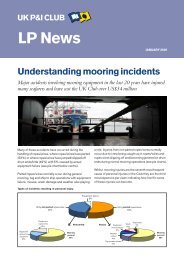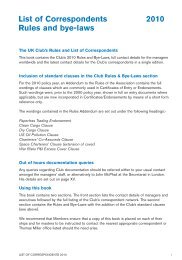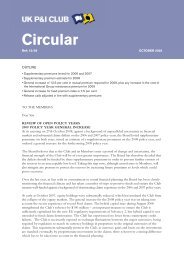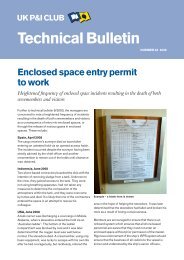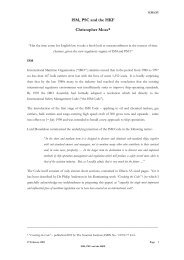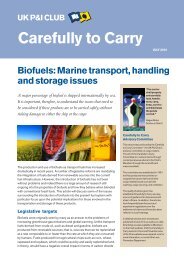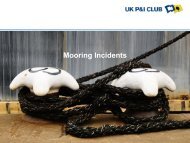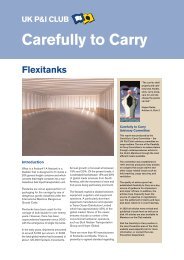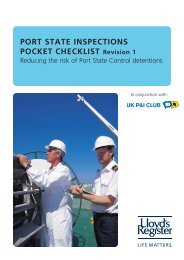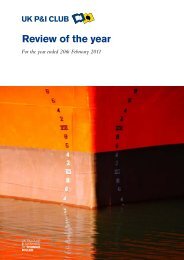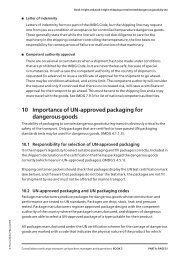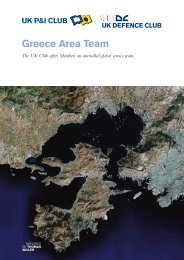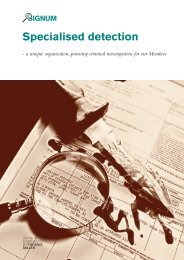Bulk Matters - UK P&I
Bulk Matters - UK P&I
Bulk Matters - UK P&I
Create successful ePaper yourself
Turn your PDF publications into a flip-book with our unique Google optimized e-Paper software.
separated ions are then detected using a conductivity<br />
detector and the peak areas reported are directly<br />
related to the concentrations. The peak areas of the<br />
individual anions (i.e. chloride) are compared to<br />
standard solutions and the concentration in the actual<br />
sample calculated. Examples of a typical anion<br />
chromatogram and standard are shown on the previous<br />
page. The determination of the cations (i.e. sodium) is<br />
done separately using the same instrument but with a<br />
different eluent and column system.<br />
Determination of cations using ICPES or AAS<br />
These two analytical techniques will determine the<br />
concentrations of various metals/cations, such as<br />
sodium, calcium, magnesium, potassium, strontium etc<br />
in an aqueous solution. The two techniques can be<br />
described as follows:<br />
●<br />
●<br />
AAS is an analytical technique in which the sample<br />
to be analysed is converted into an atomic vapour by<br />
spraying the sample or solution of the sample into a<br />
flame. The absorbence at a selected wavelength for<br />
each individual metal/cation is measured and<br />
compared to the absorbence measurements of the<br />
sample and standard.<br />
ICPES is an analytical technique where the sample<br />
solution is introduced into an inductively coupled<br />
argon plasma at a temperature of approximately<br />
8000°C. At this temperature the individual elements<br />
(cations) become thermally excited and emit light at<br />
their characteristic wavelengths. This light is<br />
collected by the spectrometer and amplified to yield<br />
an intensity measurement that can be converted to<br />
an elemental concentration by comparison with<br />
known standards.<br />
Dry cargoes (spot test)<br />
As noted before, for many dry cargoes such as steel,<br />
for example, an indication of seawater contamination<br />
can be achieved on site by the ‘silver nitrate spot test’.<br />
The basis of the test is that addition of acidified silver<br />
nitrate to any solution containing chlorides will produce<br />
a white precipitate of insoluble silver chloride. The<br />
chloride content of most seawaters would be expected<br />
to be around the 20,000 ppm level. Therefore, the<br />
addition of acidified silver nitrate to seawater will<br />
produce a dense white precipitate making the solution<br />
appear ‘milky’. The test is performed by the attending<br />
surveyor by adding a small amount of acidified silver<br />
nitrate to any contaminating water found on the dry<br />
cargo. If the resulting solution appears ‘milky’ then it is<br />
possible that seawater contamination has occurred.<br />
However, as stated previously, to confirm the presence<br />
of seawater further laboratory analysis will be required.<br />
An alternative to the silver nitrate spot test is to take<br />
swabs of the contaminating water, which should then<br />
be placed in a suitable airtight container and submitted<br />
to the laboratory for further analysis.<br />
It is important to note that certain other water sources,<br />
such as brackish or river water, will contain chlorides<br />
and would also produce a ‘milky’ solution with the<br />
addition of acidified silver nitrate. Even domestic tap<br />
water contains enough chlorides to give a slightly<br />
‘milky’ solution when tested with acidified silver nitrate.<br />
The silver nitrate spot test should be applied to<br />
galvanised goods with caution as it gives a black<br />
precipitate due to interference from the zinc present.<br />
In addition, the silver nitrate spot test can be misleading<br />
when applied to certain types of packaging, leather<br />
goods etc, which may, themselves, contain chlorides.<br />
Control samples of uncontaminated cargo should,<br />
where possible, always be obtained and/or tested<br />
in situ.<br />
Liquid petroleum cargoes (laboratory test)<br />
Unlike dry cargoes, any water contamination of a liquid<br />
petroleum cargo will become either suspended within<br />
the cargo and/or percolate through and settle on the<br />
tank bottoms. The nature of the petroleum cargo will<br />
dictate whether the contaminating water will settle to<br />
the bottom of the cargo tanks. For example, a viscous<br />
fuel oil cargo is more likely to retain the water in<br />
suspension than a gasoline or kerosene cargo.<br />
Unfortunately, water contamination of a petroleum<br />
cargo will almost certainly not be spread<br />
homogeneously throughout the entire cargo, which<br />
makes representative sampling extremely difficult.<br />
However, the identification of the type of water present<br />
can be achieved using either the AAS or ICPES<br />
techniques described previously. Prior to the use of<br />
either of these techniques, the petroleum/water sample<br />
will have to be ignited and burnt until only an ash<br />
remains. This ash is then dissolved in either an acid or<br />
a flux and an aqueous solution is prepared, which is<br />
then examined using either AAS or ICPES to determine<br />
the concentrations of the metals/cations present. The<br />
analysis of samples taken from various stages of the<br />
voyage (i.e. loadport shore tanks, after loading and<br />
before discharge) can be determined. In conjunction<br />
with the actual water content, it is then possible to<br />
produce a ‘cation fingerprint’ of the water present in the<br />
samples taken at various stages of the voyage, which<br />
can then be used to try and identify the source of the<br />
contamination.<br />
28




